Diving in Hermanus
Hermanus is known for its extensive and beautiful diving spots scattered around the Indian ocean coastline. A variety of marine species call the reefs and extensive rock formations their home. Divers have numerous exciting and interesting spots to explore in and around the area of Hermanus.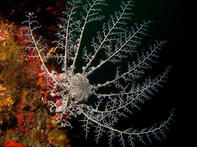
Gearing's Point Dive Spot
The Gearing’s Point dive spot in Hermanus consists of a reef that starts near the surface and surges can be expected in the shallows. You are guaranteed sightings of Shyshark, Abalone, kelp and other invertebrate life such as crayfish and crabs. Divers are encouraged to remove any garbage that they come across, as in some parts this reef looks like a junkyard with bottles, tires and nets lying around.Boiling Pot Dive Spot
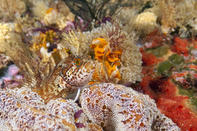
Boiling Pot dive spot is a narrow ledge with two distinct pinnacles in Hermanus. There are numerous species of hard and soft corals, including sea whips, sea fans and Gorgonians. Here you will also find a large variety of sponges, including giant orange wall sponges, as well as horsefish, klipvis, octopus, cuttlefish, shysharks, pipefish, numerous nudibranchs, huge red-baits, strawberry anemones and starfish.
You are guaranteed sightings of crayfish, abalone, kelp and sometimes seals. The name Boiling Pot is derived from the bubbling that can sometimes be seen in between the rocks due to the surge.
Preekstoel Dive Spot
Preekstoel dive spot in Hermanus has a flattish ledge that tops out at about 8 m and a small wall that drops to around 15 m below the surface. On this reef you will find numerous colourful species of hard and soft corals
There are also a large variety of sponges, including spectacular giant orange wall sponges and barrel sponges. Being in the Cape, you are guaranteed sights of crayfish, abalone, kelp and sometimes even inquisitive seals! Be on the lookout for Cape octopus, shysharks, pipefish and starfish.
The sheltered nature of this spot means that it can be divided in almost all but the worst conditions. This is a popular spot for dive training.
Blowhole Dive Spot
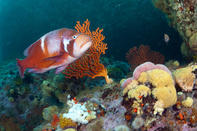
Blowhole dive spot in Hermanus has big boulders of smooth rock scattered around with sand patches in between. Sweeping kelp found all along the edges of this the blowhole dive spot and the area is buzzing with crayfish hiding in the crevices between the big boulders.
Here you will find different varieties of Nudibranchs, and be on the lookout for juveniles such as sole and rays hiding in the sand amongst the rocks. The Longsnout pipefish is a common sight, but some doublesash butterflyfish, one of the few tropical fish found in these cold waters, are also to be seen.
While swimming in between the kelp with the sun shining through the water, you have to look carefully to see the shysharks hiding under the kelp leaves. Klipfish and Red Romans are quite common in this area but beware of urchins hiding under the sand.
Hakskeen Dive Spot
Hakskeen dive spot is made up of a pinnacle that is at some places very close to the surface. It has steep drop-off's with a large sand gully separating the shallow and the deep pinnacle. The reef is home to a large crayfish population and the kelp helps them to hide from the outside world.
There are a great number of red-bait growing on this reef, together with featherstars, bright coloured sea fans, wallsponges and various nudibranchs that can be seen all along the reef. Fish such as klipfish, rocksucker and Knysna sandgobies are found in this area. This is a dive for the advanced diver and it has a really exciting wall to dive.
Table Top Dive Spot
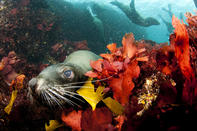
Table Top dive spot in Hermanus has a large portion that is flat with drop-off’s along the sides. The first is a drop-off to 22m and then one to 40m which is quite spectacular.
Along this reef there are the most beautiful pink and white noble coral and featherstars waving in the surge. Also found on this reef are red-bait, Sea fans, bright orange wallsponges and different species of nudibranchs living amongst the soft and hard corals.
Fish species encountered in this area include puffadder shyshark, leopard catshark, longsnout pipefish and the common speckled klipfish. Seals are also frequently seen on this beautiful reef which is best dived on a day with full sunlight.
Rietfontein Reef Dive Spot
Rietfontein Reef dive spot, also known as Tamatiebank, is a broken reef with a lot of sand gullies. The reef is rather flat on top. In between big crevices and some of the drop-off’s you will find that it is deeper than the rest of the reef. Lots of kelp fill up the space between the crevices and make it a great place for crayfish and Shysharks to hide.
This reef has a lot of activity, ranging from shovelnose lobsters to octopus, and abalone and even gully sharks like to hang about in this area. Dusky sharks, klipfish and numerous nudibranchs have been found on this reef. Waving kelp and big orange sponges make it a very beautiful dive with different sea-pens and starfish decorating the reef in spectacular colours.
Be on the lookout for ghost nudibranchs sitting on the orange sponges. This is a really nice dive but beware of the surge that can sometimes be very strong.
Skulphoek Dive Spot
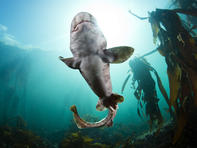
Skulphoek dive spot is an extensive reef that has big flat bare areas with spectacular drop-offs that are drenched in pink cold-water coral. Here you will find a large variety of sponges and numerous species of hard and soft corals, including Gorgonians, sea fans and sea whips.
Horsefish, shovelnose lobsters, octopus, cuttlefish, klipvis, shysharks, pipefish and numerous nudibranchs are common. Bright coloured anemones and brittle stars cover big areas of the rock surface. Being in the Cape, you are guaranteed sightings of crayfish, abalone and kelp. This reef is normally calm and without any surge because of its depth.
 Hermanus is a scenic and thriving holiday destination that offers visitors accommodation in Hermanus with modern amenities while retaining i...
Hermanus is a scenic and thriving holiday destination that offers visitors accommodation in Hermanus with modern amenities while retaining i... Hermanus is a pleasant seaside resort town, situated just 120 km east of Cape Town. Hermanus is probably most well known for its magnificent...
Hermanus is a pleasant seaside resort town, situated just 120 km east of Cape Town. Hermanus is probably most well known for its magnificent...